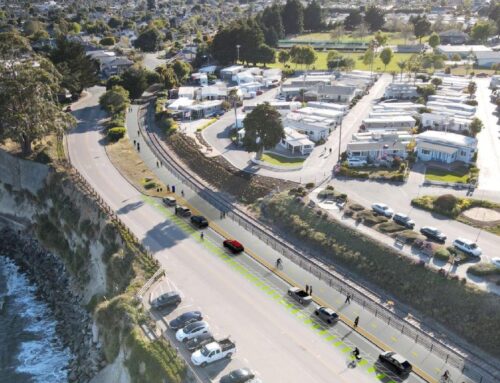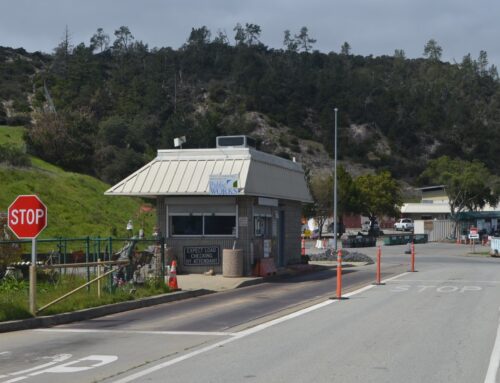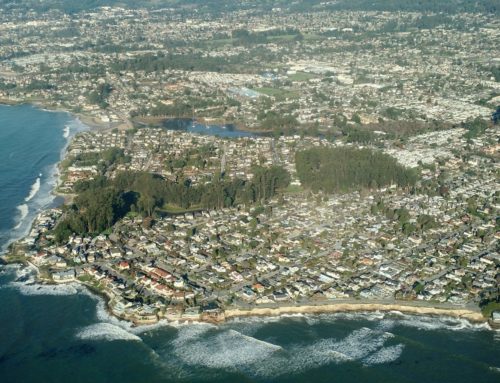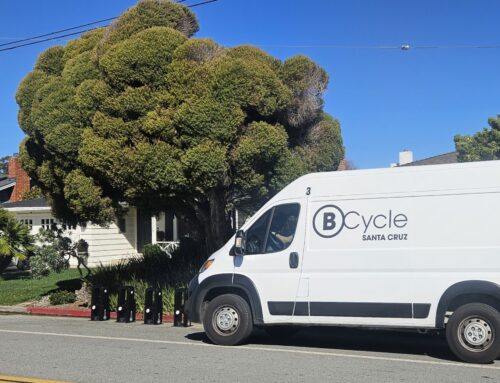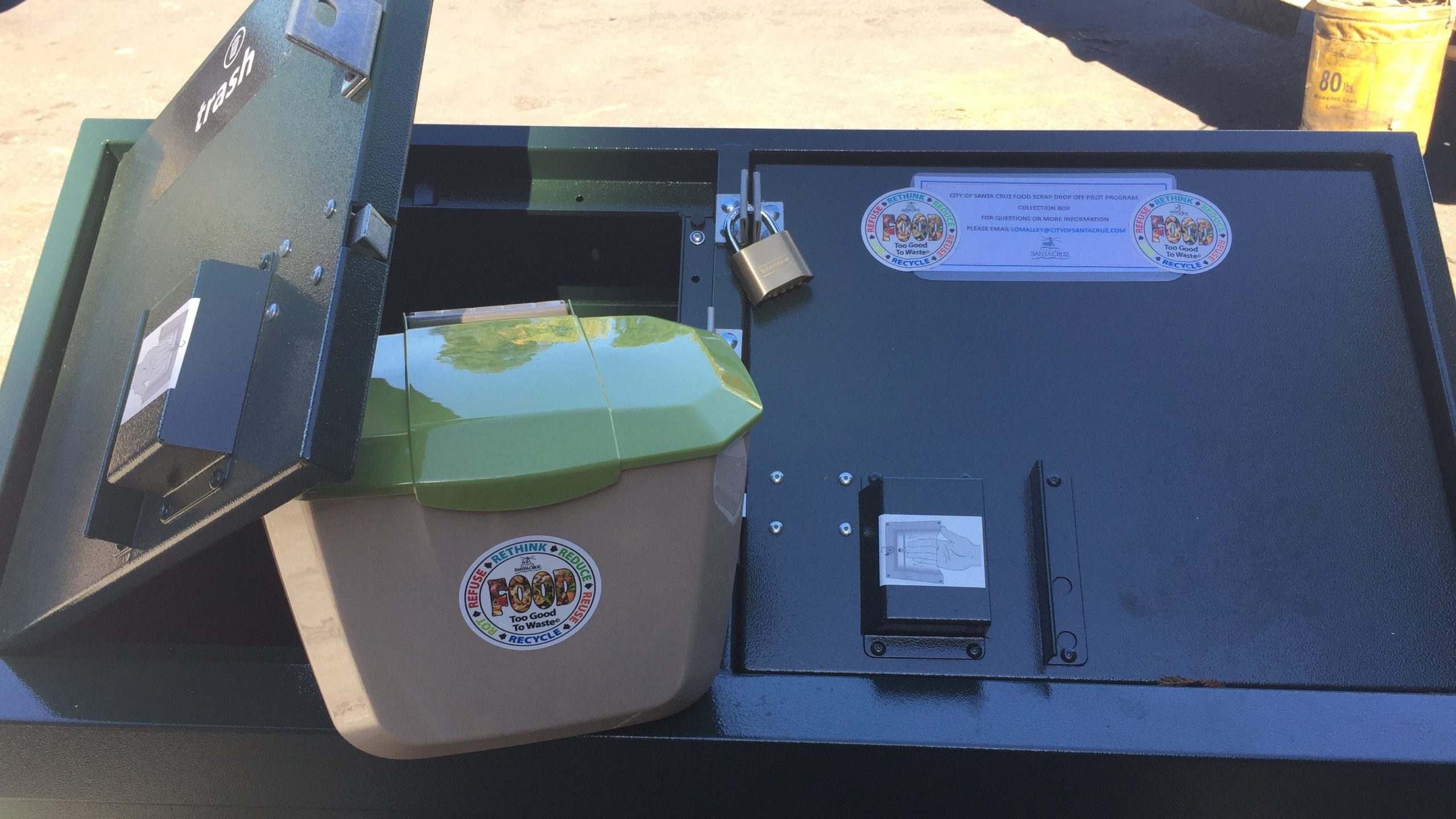
A pail similar to this one is expected to be given to Santa Cruz city residents for curbside food-scrap collection in 2022. (City of Santa Cruz — Contributed)
SANTA CRUZ >> Most Santa Cruz County residents will be able to include food scraps in their green yard waste bins during weekly pickups next year because of a new state law. The law essentially compels garbage haulers to collect food waste separately from trash in 2022, divert organic waste from landfills and increase large-scale composting.
The statewide goal is to reduce 75% of food waste that is sent to landfills compared with 2014 levels. At Santa Cruz’s landfill on Dimeo Lane, for instance, nearly 25% of the garbage is from food, city officials have said.
Unlike the rest of the county, Santa Cruz city residents are expected to get a separate food waste pail that will be collected during weekly garbage pickups in the spring of 2022, city officials said. The pails are the same ones used in a pilot program this year, said Leslie O’Malley, the city of Santa Cruz’s waste production reduction manager.
Watsonville residents will be expected to put food waste in yard trimming bins by summer, city officials said.
In Capitola, Scotts Valley, Live Oak and other unincorporated areas of Santa Cruz County, residents are expected to include food waste in yard trimming bins. Greenwaste is the trash and recycling hauler in those areas.
“It will be a transition for some that, you know, the idea of recycling organics is new to them,” said Sara Treat, GreenWaste’s customer service and outreach manager. “But a lot of people are excited about it and ready to start the program.”
Timing
In Capitola and Scotts Valley, residents are expected to be able to include food scraps in their yard waste bins starting Jan. 1.
In Watsonville, residents who don’t yet have yard waste bins are expected to receive them by June 2022.
Live Oak, Soquel, Aptos the San Lorenzo Valley and other unincorporated county areas are likely to have food waste collected in their yard waste bins in 2022 but it’s not yet clear when, Greenwaste representatives said.
Acceptable food waste
Larry Laurent, Capitola’s assistant to the city manager, said his city’s rules were based on the state guidelines. Similar rules are expected in the other cities.
Capitola leaders said items accepted in yard waste bins will include:
- Fruits, vegetables, prepared foods, solid dairy items, coffee grounds, coffee filters, tea bags, flowers and other plants.
Items that will not be accepted include:
- Liquids, raw meats, cat litter, food packaging including “compostable” plastics such as clamshell containers and cups.
During a Dec. 1 Capitola City Council meeting, Laurent said organic waste would be hauled to the Monterey Regional Waste Management District near Marina.
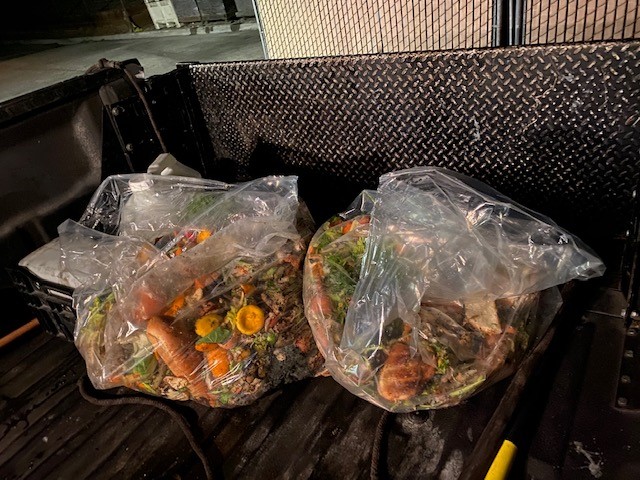
Food waste is collected in a city of Santa Cruz pilot program in 2021. (City of Santa Cruz — Contributed)
City of Santa Cruz
Santa Cruz city residents are expected to see the biggest changes in food waste collection starting in spring 2022. Starting on the Eastside and spreading west, city residents will receive 6-gallon pails for food scraps to be collected during regular weekly curbside garbage and recycling pickup.
Leslie O’Malley, the city of Santa Cruz’s waste production reduction manager, said “supply chain issues” have led to the pails’ expected delivery in the spring.
Watsonville
In Watsonville, nearly half of residents have green yard waste bins but several thousand residents do not, said Christian Di Renzo, Wastonville’s interim public works and utilities director.
Because the yard waste bins will now be used for food scraps, Di Renzo said everyone will be given yard waste bins by June 2022. A media campaign is expected in the spring, Di Renzo said.
On Nov,. 9, the Watsonville City Council voted to spend $300,000 for 6,000 35-gallon yard waste bins for residents who don’t have them.
Once the food scraps are collected, they will be taken to Monterey to be composted, Di Renzo said. “Part of the requirement is that we procure compost back,” he said. “So we generate the waste stream and we buy it back as a compostable for distribution throughout the community.”
Di Renzo said the city of Watsonville is still figuring out the market for compost in the community and how to implement the distribution.
Capitola and Scotts Valley
Capitola and Scotts Valley have their waste hauled under contract with San Jose-based GreenWaste Recovery Inc. The plan is to begin food scrap collection in the yard trimmings bins starting Jan. 1, said Greenwaste representative Sara Treat.
Once the organics and food scraps are collected by GreenWaste, they are then taken to be composted by the Keith Day Company, which is based in Salinas.
Live Oak, Soquel, Aptos, Freedom, San Lorenzo Valley and other unincorporated county areas
For the rest of unincorporated Santa Cruz County, Treat said it’s likely but not yet certain that residents will use their green yard waste bins for food scraps. It’s not yet clear when in 2022 the transition will happen.
Monthly Rates
Capitola: Residents pay $18.15 for a 32-gallon trash bin. The rate will rise to $25.81 on Jan. 1.
Santa Cruz: Residents pay $32.04 for a 32-gallon trash bin. There are no plans to increase rates, O’Malley said.
Watsonville: Residents pay $35.65 for a 32-gallon trash bin. The rate is expected to stay the same through June 2022, Di Renzo said.
Scotts Valley: Residents pay $22.84 for a 35-gallon trash bin. The rate for a 32-gallon bin will rise to $25.81 on Jan. 1.
Live Oak, Aptos, San Lorenzo Valley, other unincorporated areas of Santa Cruz County: Residents pay $30.68 for a 32-gallon trash bin.
Allison Gasparini is a science writer and recent graduate of the UC Santa Cruz Science Communication master's program. She has written for the Monterey Herald, the Mercury News and Forbes' science section.


